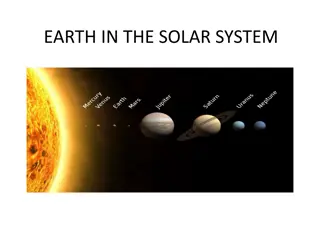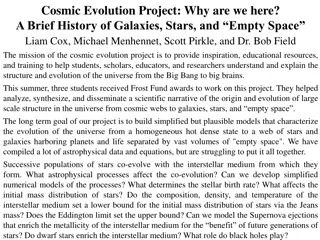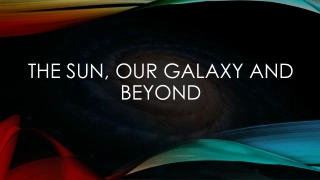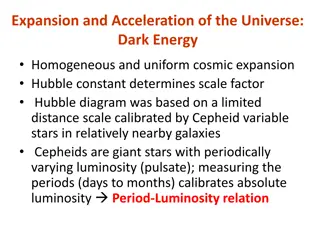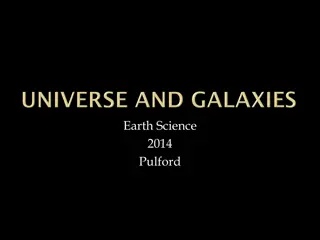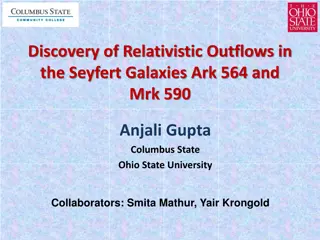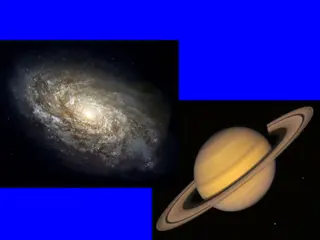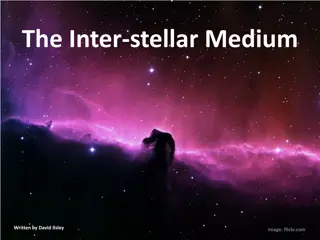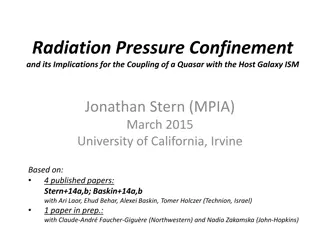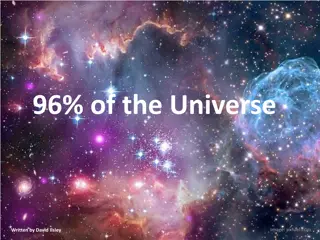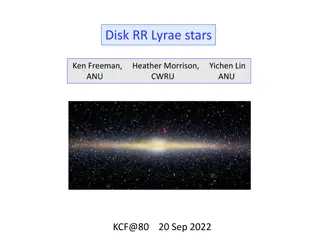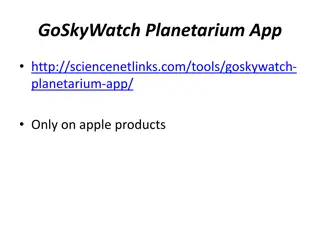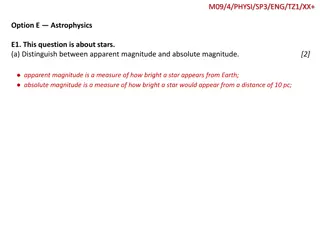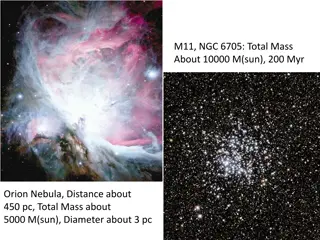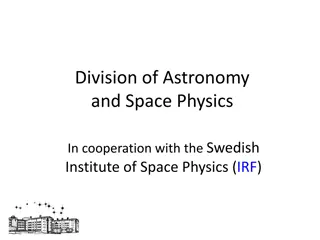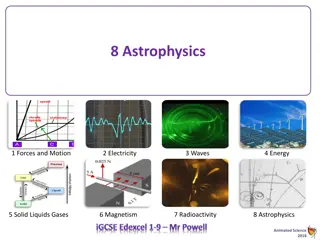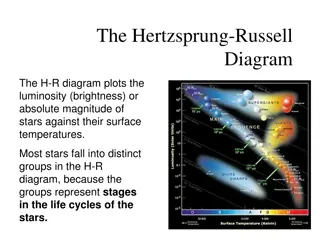Exploring the Vast Universe: Stars, Galaxies, and Beyond
Delve into the immense scale of the universe as we uncover the characteristics of stars, their compositions, temperatures, and distances from Earth. Learn how spectroscopy reveals the elements within stars, discover mnemonic devices for remembering star temperatures, and explore methods such as parallax used to measure distances in space. Engage with fascinating facts about star sizes, surface temperatures, and the incredible distances that light travels.
Download Presentation

Please find below an Image/Link to download the presentation.
The content on the website is provided AS IS for your information and personal use only. It may not be sold, licensed, or shared on other websites without obtaining consent from the author. Download presentation by click this link. If you encounter any issues during the download, it is possible that the publisher has removed the file from their server.
E N D
Presentation Transcript
Chapter 27 Stars and Galaxies The Universe is immense. We are only now beginning to comprehend how big. For Earth Day U.S. Dept of the Interior: Engaging the next generation 3-20-14 http://www.youtube.com/watch?v=ZVR8kbAUXUc Scale of the Universe https://www.youtube.com/watch?v=uaGEjrADGPA Scale (CERN version) https://www.youtube.com/watch?v=XRdh8gmVR90
Stars vary tremendously in size Red Giants Dwarf Stars vary in size and mass. From smaller than earth to 1,000 larger than our sun. From 1/50th to 50 the sun s mass. Star size comparison http://www.wimp.com/starsize/
27.1 The Characteristics of Stars Star body of gases releasing radiant energy in the form of light and heat. Represents the most fundamental building blocks of galaxies. We characterize stars by... composition temperature distance from earth brightness. What is the name of our closest star?
Composition of Stars Using spectroscopy, we can determine elements based on wavelength Composition: Hydrogen is the most abundant element of stars Our sun is 91.2% hydrogen and 8.7 % helium... 99.9% Most stars are 70% hydrogen and 28% helium Hydrogen is the main element that fuels stars!
Temperature of Stars The surface temperature of a star determines its color Most stars are between 2,800 and 24,000 OLD text p. 547 Blue stars can be as hot as 50,000 Mnemonic devices: Oh Be A Fine Girl, Kiss Me Oh Boy, An F Grade Kills Me Our sun has a surface temperature of ~ 5,500
Distance from Earth We measure small distance in space in Astronomical Units (A.U.), the average distance between Earth and the Sun. We measure large distances in space in Light Years. Light year the distance that light travels in one year. The speed of light is nearly 300,000,000 m/s (Actually 299,792,458 m/s or 670,616,629 mph in a vacuum; slows slightly through matter) Other cool facts... It takes ~ 8.3 minutes for the sun s light to reach Earth (8 light minutes) Proxima Centauri (closest star) is 4.3 light years away Sirius (brightest star) is 9 light years away Polaris is 700 light years away Farthest we can see? Deneb is the 20th brightest star, but about 1,550 light-years away
How do we know distances? Parallax the apparent shift in location of an object due to a change in the position of the observer d = 1/p d = distance to star in parsecs p = parallax angle of the star in arc sec 1 Parsec = 3.2616 light years New Text p. 702
Brightness Apparent magnitude brightness of a star as it appears from earth Absolute magnitude true brightness; how bright a star would appear from 10 Parsecs, or 32.6 light yearsaway. New txt p. 703, Old txt p. 553
Classification of Stars H-R Diagram (Hertzsprung Russell Diagram) Plots surface temperatures against absolute magnitude. Brightness of most stars increases as surface temperature increases. Stars pass through series of stages based on mass. Most stars fall in the middle of diagram (Main Sequence) New txt p. 704, Old txt p. 554 Main Sequence: cool, dim, red stars at lower right to hot, bright, blue stars at upper left. Giants & Supergiants: cool, bright in the upper right White dwarfs: hot, dim in the lower left
Classification of Stars Types of stars: https://www.youtube.com/watch?v=nCUS2uNGw7k



